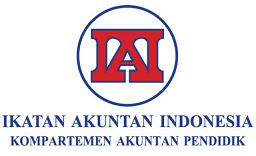FAKTOR-FAKTOR YANG MEMPENGARUHI KUALITAS AUDIT DALAM MENDETEKSI BUKTI-BUKTI KECURANGAN DI LAMPUNG INDONESIA
Abstract
Terbukti dari temuan Indonesia Fraud Survey 2019 yang dilakukan oleh ACFE Indonesia, mengungkapkan bahwa laporan merupakan alat yang paling umum untuk mendeteksi kecurangan, kinerja unit pengawasan internal sebagai auditor internal dinilai kurang optimal. Auditor internal berkontribusi 23 hingga 40 persen dalam mendeteksi kecurangan. Hal ini menunjukkan bahwa kapasitas auditor internal untuk mengidentifikasi aktivitas penipuan tidak berada pada level tertinggi. Menurut studi teoritis dan temuan empiris, kapasitas untuk mendeteksi kecurangan dapat dihalangi oleh Kualitas Audit seperti menerima penjelasan auditee yang tidak memadai, gagal mengejar item yang diaudit, dan keluar sebelum waktunya. Beberapa elemen, termasuk komitmen profesional, sikap, dan kinerja, telah ditemukan mempengaruhi Kualitas Audit.
Penelitian ini bertujuan untuk mengetahui implikasi karakteristik auditor yang terdiri dari seperti komitmen profesional, kepribadian, dan kinerja terhadap kualitas audit serta konsekuensi dari perilaku ini terhadap kapasitas seseorang untuk menemukan aktivitas kecurangan. Untuk keperluan penelitian ini, auditor internal yang bekerja di Unit Audit Internal Universitas Islam di Indonesia akan menjadi unit analisis. Penelitian ini menggunakan random sampling. Pemodelan persamaan struktural berbasis kovarian digunakan untuk menganalisis data (SEM).
Downloads
References
Aranya, N., & Ferris, K. R. (1984). A Reexamination of Accountants’ Organizational-Professional Conflict. The Accounting Review, 59(1), 1–15.
Arens, A. A., & Loebbecke, J. K. (1996). Auditing, Pendekatan Terpadu (1st ed.). Jakarta Salemba Empat.
Coram, P., Ng, J., & W. (2003). A Survey of Time Budget Pressure and Reduced Audit Quality Among Australian Auditors. Australian Accounting Review, 13(1), 38–44. https://doi.org/https://doi.org/10.1111/j.1835-2561.2003.tb00218.x
Coram, P., Ng, J., & Woodliff, D. (2003). A Survey of Time Budget Pressure and Reduced Audit Quality Among Australian Auditors. Australian Accounting Review, 13(29), 38–44. https://doi.org/10.1111/j.1835-2561.2003.tb00218.x
Favere-Marchesi, M. (2000). Audit Quality in ASEAN. International Journal of Accounting, 35(1).
Hair, J.F., Black, W.C., Babin, B.J. and Anderson, R. E. (2014). Multivariate Data Analysis (7th ed.). Pearson Education.
Heider, F. (1958). The Psychology of Interpersonal Relations. Wiley.
Herrbach, O. (2001). Audit quality, auditor behaviour and the psychological contract. European Accounting Review, 10(4), 787–802.
Ichsan Satya Anugrah, Kamaliah, & Elfi Ilham. (2017). Pengaruh Time Budget Pressure, Kompetensi Dan Independensi Terhadap Kualitas Audit Dengan Etika Profesi Sebagai Variable Moderasi. JOM Fekon, 4(1), 1322–1336.
Indonesia, A. (2019). Survei Fraud Indonesia 2019.
K H Spencer Pickett. (2010). The Internal Auditing Book. In Wiley (Vol. 3).
Kasigwa, G., Munene, J. C., & Ntayi, J. (2013). Reduced Audit Quality Behavior Among Auditors in Uganda. African Journal of Accounting, Economics, Finance and Banking Research, 9(9).
Koroy, T. R. (2008). Pendeteksian Kecurangan (Fraud) Laporan Keuangan oleh Auditor Eksternal. Akuntansi Dan Keuangan, 10(1). https://doi.org/https://doi.org/10.9744/jak.10.1.PP.%2022-23
McKnight, C. A., & Wright, W. F. (2011). Characteristics of relatively high-performanceauditors. Auditing, 30(1), 191–206. https://doi.org/10.2308/aud.2011.30.1.191
Moeller, R. (2016). Brink’s Modern Internal Auditing: A Common Body Of Knowledge. John Wiley & Sons Inc.
Moyes, G. D., & Hasan, I. (1996). An empirical analysis of fraud detection likelihood. Managerial Auditing Journal, 11(3), 41–46. https://doi.org/10.1108/02686909610115231
Nehme, R., AlKhoury, C., & Al Mutawa, A. (2020). Evaluating the performance of auditors: a driver or a stabilizer of auditors’ behaviour. International Journal of Productivity and Performance Management, 69(9), 1999–2019. https://doi.org/10.1108/IJPPM-08-2018-0306
Paino, H., Smith, M., & Ismail, Z. (2012). Auditor acceptance of dysfunctional behaviour: An explanatory model using individual factors. In Journal of Applied Accounting Research (Vol. 13, Issue 1, pp. 37–55). https://doi.org/10.1108/09675421211231907
Pierce, B., & Sweeney, B. (2005a). Management control in audit firms - Partners’ perspectives. Management Accounting Research, 16(3 SPEC. ISS.), 340–370. https://doi.org/10.1016/j.mar.2005.06.008
Pierce, B., & Sweeney, B. (2005b). Management control in audit firms—Partners’ perspectives. Management Accounting Research, 16(3), 340–370. https://doi.org/https://doi.org/10.1016/j.mar.2005.06.008
Qodarie, F., Utary, A. R., & Yudaruddin, R. (n.d.). Analisis Penugasan Distribusi Dengan Menggunakan Metode Hungarian Pada PT. Air Kristal Lestari Kota Balikpapan.
Robert R. Moeller. (2016). Brink’s Modern Internal Auditing. In Wiley (Vol. 8).
Sekaran, U. dan Bougie, R. (2016). Metode Penelitian untuk Bisnis: Pendekatan Pengembangan Keterampilan (7th ed.). Wiley & Sons.
Sundari, S. (2018). Determinants of Reduced Audit Quality Behavior in Indonesia. In International Journal of Innovative Science and Research Technology (Vol. 3, Issue 8). www.ijisrt.com74
Verwey, I. G. F., & Asare, S. K. (2022). The Joint Effect of Ethical Idealism and Trait Skepticism on Auditors’ Fraud Detection. Journal of Business Ethics, 176(2), 381–395. https://doi.org/10.1007/s10551-020-04718-8
Weinberg, S. L., & Abramowitz, S. K. (2002). Data analysis for the behavioral sciences using SPSS. Cambridge University Press.
Zack, G. M. (2013). Financial Statement Fraud: Strategies for Detection and Investigation. John & Sons. Inc

This work is licensed under a Creative Commons Attribution-NonCommercial-ShareAlike 4.0 International License.
Jurnal Akutansi dan Keuangan allows readers to read, download, copy, distribute, print, search, or link to the full texts of its articles and allow readers to use them for any other lawful purpose. The journal allows the author(s) to hold the copyright without restrictions. Finally, the journal allows the author(s) to retain publishing rights without restrictions
Authors are allowed to archive their submitted article in an open access repository
Authors are allowed to archive the final published article in an open access repository with an acknowledgment of its initial publication in this journal







